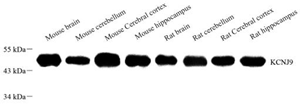Anti-GIRK-3 Rabbit pAb (100 μl)
| Reactivity: | M,R |
| Applications: | WB |
| Host Species: | Rabbit |
| Clonality: | Polyclonal |
| Full Name: | GIRK-3 rabbit polyclonal |
Gene Name: | G protein-activated inward rectifier potassium channel 3 |
Synonyms: | GIRK-3, Kcnj9, Girk3, KIR3.3, Potassium channel, Potassium inwardly rectifying channel subfamily J9 |
Immunogen: | KLH conjugated Synthetic peptide corresponding to Mouse GIRK-3 |
Isotype: | IgG |
Purity: | Affinity purification |
Predicted MW. | 44 kDa |
Observed MW. | 44 kDa |
Uniprot ID: |
Product Usage Information
Applications | Species | Dilution | Positive tissue |
WB | Mouse, Rat | 1: 500-1: 1000 | brain, cerebellum, cerebral cortex, hippocampus |
Background
KCNJ9 belongs to the inward rectifier-type potassium channel family and is controlled by G proteins. It associates with another G-protein-activated potassium channel to form a heteromultimeric pore-forming complex. Inward rectifier potassium channels are characterized by a greater tendency to allow potassium to flow into the cell rather than out of it. Their voltage dependence is regulated by the concentration of extracellular potassium; as external potassium is raised, the voltage range of the channel opening shifts to more positive voltages. The inward rectification is mainly due to the blockage of outward current by internal magnesium.
Images
 | Western blot analysis of GIRK-3 (GB113321) at dilution of 1: 1000 |
Storage
| Storage | Store at -20°C for one year. Avoid repeated freeze/thaw cycles. |
| Storage Buffer | PBS with 0.02%sodium azide,100 μg/ml BSA and 50% glycerol. |



